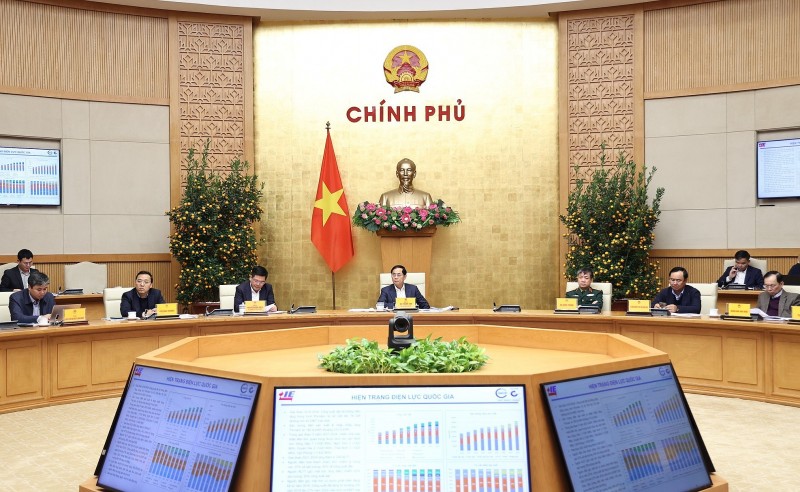
In carrying out the task of developing the Adjustment Plan for the National Power Development Plan for the 2021-2030 period, with a vision to 2050 (Power Plan VIII), which was approved by the Prime Minister under Decision No. 1710/QĐ-TTg dated December 31, 2024, the Ministry of Industry and Trade has actively and urgently coordinated with relevant ministries, sectors, and agencies to complete the necessary procedures and finalize the plan.
The Adjustment Plan for Power Plan VIII has been completed by the Ministry of Industry and Trade in accordance with the provisions of the Planning Law and Decree No. 37/2019/NĐ-CP dated May 7, 2019, which provides detailed regulations on the implementation of certain provisions of the Planning Law.
The Ministry of Industry and Trade has also conducted extensive consultations, published the draft on the Government and Ministry of Industry and Trade's online portals, and sought input from ministries, sectors, local authorities, relevant agencies, and members of the Appraisal Council before reporting to the Chairman of the Appraisal Council to convene the appraisal meeting as required.
The content of the Adjustment Plan for Power Plan VIII has been developed based on strict compliance with the resolutions of the Party, the National Assembly, and the Government. It aligns with Vietnam’s National Energy Development Strategy to 2030, with a vision to 2045, as outlined in Resolution No. 55-NQ/TW dated February 11, 2020, of the Politburo. It also adheres closely to the national master plan approved by the National Assembly under Resolution No. 81/2023/QH15 dated January 9, 2023, as well as international commitments and agreements.

At the meeting, the representative of the Ministry of Industry and Trade summarized some calculation results of the Adjustment Plan for Power Development Plan VIII as follows:
The total power generation capacity serving domestic demand (excluding exports, cogeneration sources, and risk-prone thermal power) is 183,291-236,363 MW, an increase of approximately 27,747-80,819 MW compared to the approved Power Development Plan VIII. Specifically:
Coal-fired power: 31,055 MW (accounting for 16.9-13.1%), unchanged from Power Development Plan VIII (the increase in capacity is due to the update of actual unit capacities of power plants).
Domestic gas-fired power: 10,861 MW (accounting for 5.9-4.6%), unchanged from Power Development Plan VIII.
LNG-imported power: 8,824 MW (accounting for 4.8-3.7%), reduced by 13,576 MW compared to Power Development Plan VIII (due to assessing delayed power sources).
Hydropower: 33,294-34,667 MW (accounting for 18.2-14.7%), increased by 4,560-5,275 MW compared to Power Development Plan VIII.
Regarding renewable energy sources, biomass, waste-to-energy, geothermal power, energy storage, and flexible power sources:
Total onshore wind power capacity: 27,791-28,058 MW (accounting for 13.2-14.4%), an increase of 3,949-5,321 MW compared to Power Development Plan VIII.
Total solar power capacity (including centralized solar power and rooftop solar power): 46,459-73,416 MW (accounting for 25.3-31.1%), an increase of 25,867-52,825 MW compared to Power Development Plan VIII.
Biomass power, waste-to-energy, and geothermal power: 2,979-4,881 MW (accounting for 1.6-2.1%), an increase of 709-2,611 MW.
Energy storage: 12,394-22,271 MW (accounting for 6.8-9.4%), an increase of 9,694-19,571 MW compared to Power Development Plan VIII.
Flexible power sources: 2,000-3,000 MW (accounting for 1.1-1.3%), an increase of 1,700-2,700 MW compared to Power Development Plan VIII.
Regarding electricity import, export, and nuclear power development:
Imported power: about 9,360 MW (accounting for 5.1-4.0% of total power plant capacity), an increase of 4,360 MW compared to Power Development Plan VIII.
Electricity exports: expected to reach approximately 5,000-10,000 MW, ensuring high economic efficiency, national energy security, and national defense.
Nuclear power: projected to reach 6,000-6,400 MW, operational between 2030-2035.
At the meeting, based on the feedback from three reviewing council members and other appraisal council members regarding the Adjustment Plan for Power Development Plan VIII, Minister Nguyễn Hồng Diên addressed and clarified several key points:
First, the electricity demand forecast was conducted under three scenarios corresponding to three GDP growth projections. The electricity demand growth rate under the base load scenario for the 2026-2030 period is 10.3% per year (corresponding to an average GDP growth rate of approximately 8.0% per year for this period), and the high-load scenario is 12.5% per year (corresponding to an average GDP growth rate of 10.0% per year). These projections are considered reasonable to ensure sufficient electricity for economic and social development.
Second, the power generation development program is designed based on adherence to policies, strategic orientations for economic and social development, national security and defense assurance, environmental protection, and meeting set objectives. It maximizes the utilization of approved power sources in Power Development Plan VIII, increases electricity imports, and limits further development of interregional transmission grids.
Accordingly, the total domestic power generation capacity (excluding exports, cogeneration sources, and risk-prone thermal power) is projected to be 183,291-236,363 MW, an increase of approximately 27,747-80,819 MW compared to the approved Power Development Plan VIII. This additional capacity mainly comes from hydropower, renewable energy sources, and battery storage.
The Minister of Industry and Trade further explained specific adjustments to power sources and transmission grids as follows:
Coal-fired power: By 2030, the total coal-fired power capacity remains unchanged from the approved Power Development Plan VIII (31,055 MW). However, it increases by 928 MW compared to the original plan due to updated actual capacities of thermal power units.
Domestic gas-fired power: The total capacity by 2030 is 10,861 MW, unchanged from Power Development Plan VIII.
LNG-imported power: The adjustment aims to maximize the approved projects in Power Development Plan VIII while assessing project implementation progress to propose alternative solutions for delayed projects beyond 2030. The total capacity by 2030 is 8,824 MW.
Hydropower: By 2030, the country will fully develop its hydropower potential, with large and medium-scale hydropower reaching approximately 21,100 MW (including expansion projects), increasing by 1,600 MW; small hydropower reaching 13,500 MW, an increase of 5,400 MW compared to the approved Power Development Plan VIII.
Onshore and nearshore wind power: By 2030, the total onshore and nearshore wind power capacity will reach approximately 27,791-34,667 MW, an increase of about 3,949-5,321 MW compared to the approved Power Development Plan VIII.
Offshore wind power: By 2030, offshore wind power remains an expensive investment option. Power Development Plan VIII initially projected around 6,000 MW by 2030. However, the Adjustment Plan shifts offshore wind power development beyond 2030, targeting 17,000 MW by 2035.
Solar power: By 2030, the total capacity of centralized solar power (including ground-mounted, floating, and rooftop solar) is expected to reach 46,459-73,416 MW, an increase of 25,867-52,825 MW compared to the approved Power Development Plan VIII. Solar power has the advantage of rapid deployment, meeting urgent electricity supply needs in 2026-2027.
Nuclear power: Future nuclear power investments remain costly due to strict nuclear safety requirements. Following directives from Party and State leadership, the Ninh Thuận 1 and 2 nuclear power plants, with a total capacity of 6,000-6,400 MW, are expected to be operational between 2030-2035. By 2050, an additional 4,500-5,000 MW of nuclear power will be required in the North and about 3,000 MW in the Central region (primarily small modular reactors - SMR) to provide a stable baseload power supply.
Nuclear power site research will continue for future development in post-Power Development Plan VIII planning periods.
Third, the power transmission development program is based on the selection of an optimal power generation scenario. The transmission grid will be developed to ensure safe and stable operation, integrate high proportions of renewable energy, resolve overloads, congestion, low voltage quality, and other technical challenges in grid operation.
Fourth, total investment in power sector development remains substantial (estimated at $136-172 billion for 2026-2030, including $118-148 billion for power generation and $18-24 billion for transmission grids). The Adjustment Plan for Power Development Plan VIII proposes solutions for capital mobilization, diversifying funding sources (bank credit, aid, stock market, etc.), and attracting both domestic and foreign investments. It also encourages private sector participation in the power industry.

Ngan Thanh Technology Company Limited
Address: Hamlet 5, Group 55, Tam An Commune, Long Thanh District, Dong Nai Province, Vietnam
Email: nganthanh.cleantech@gmail.com
Hotline: 0978 390 739
TIN: 3603957845
Receive news about the latest products and solutions